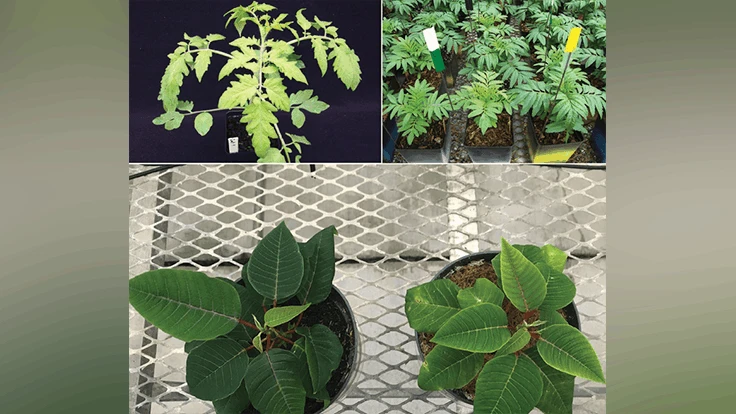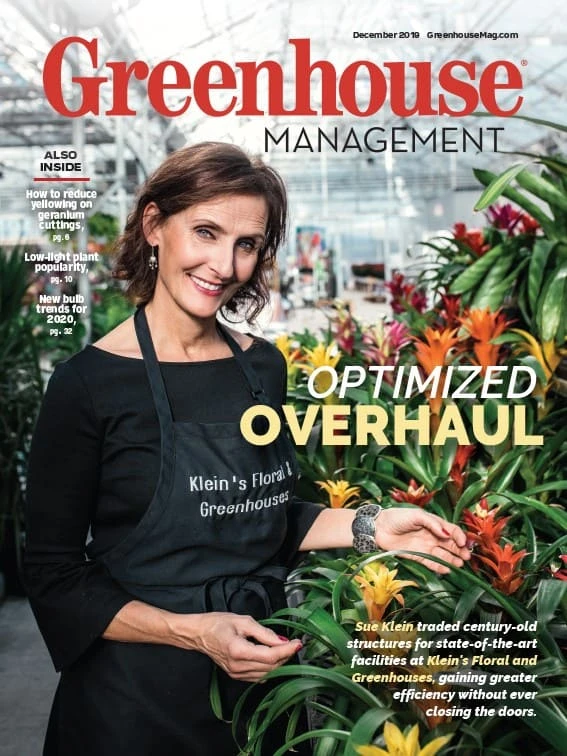

Growers most often do not like to change the fertility programs that they are using and have used for years. Some new crops require some minor tweaking of dosage, fertilizer formulations, frequency of fertility, etc., but for the most part the fertility requirements (plus optimal substrate pH ranges) are pretty well dialed in. Then along comes wood fiber in growing media and the game changes a bit!
As noted over the past decade by growers and researchers alike, the most frequent and noticeable changes in cultural practices when switching to a mix that contains wood products are 1) irrigation management, 2) pH management and 3) fertility. Now, not all growers see changes or face challenges in all of those areas but many do see some. Not on that list is green wood toxicity (phytotoxicity) that can be present in freshly harvested/processed pine tree substrate (PTS; hammer milled product). Despite some changes to growing practices, growers are rapidly trialing and adopting wood in their mixes due to the many positives of using them. One “trend” that we are seeing across North America and some in Europe is the increase of wood product percentages in various greenhouse substrates. At this time, the “typical” and most common wood amendment rate is between 20 and 40% (by volume). Above this threshold, the changes in growing practices can change substantially. For the purpose of this article, we want to focus on one nutritional challenge that we have seen in a few growing operations this year: sulfur-deficient plants.
Fortunately, there is a decent amount of research trial data on the issues and potential solutions when growing greenhouse crops in high-percentage wood materials. As we and others have written before, the initial research on wood substrates in the U.S. started in 2004 and at that time most of the focus was on figuring out if and how we could grow crops in 100% engineered wood. Even though all research from 2004-2015 focused on hammer-milled PTS materials, those trials and data can (and do) still apply to the commercial wood products on the market today that are made with different manufacturing equipment and processes.

As it relates specifically to sulfur nutrition in greenhouse crops, we do not know everything about when, how, to what extent and at what exact percentages of wood deficiency occurs, but we do know that crops grown in substrates with a high percentage of wood products can exhibit sulfur-related growth deficiencies.
Sulfur is one of the essential nutrients needed in the growth of plants, however, at a lower concentration compared to many other nutrients. Sulfur is often found inherently in peat and other organic substrates at high enough levels to supply plants with all they need with no/low additional supplement via the fertility program. Sulfur deficiency symptoms can include chlorosis and necrosis of the youngest leaves, branchless roots, reduction in chlorophyll content (Fig. 1), reduced stomatal conductance, transpiration and photosynthesis, as well as overall reduced plant growth.
Back in 2004-2005, when the early work was being done on wood substrates, it was initially thought that nitrogen was the only (or at least the main) limiting nutrient affecting plant growth and causing yellowing of foliage and stunted growth. It is well known that nitrogen is immobilized (tied up) by microbes in the degradation of organic substrates and therefore plant available nitrogen can be limited (and cause severe yellowing and stunting) when fresh wood is in a substrate. Thanks to many years of previous research on sulfur nutrition of nursery crops in pine bark substrates, Dr. Robert Wright at Virginia Tech was instrumental in suggesting, and later discovering, that sulfur was also a limiting factor in plants grown in 100% pine wood. Over the next decade, trials were initiated on several crops including geraniums, marigold, poinsettia and mums to evaluate their response to various sulfur nutrition treatments, sulfur types and amendment rates (Fig. 2). Sulfur deficiencies in wood-based substrates can be exacerbated by the inherently low concentrations of sulfur in pine wood (also bark) and also by the microbial immobilization of sulfur (and phosphorus) that does occur in organic substrates, just to a lesser extent than nitrogen.

One of the trials conducted evaluated the growth of marigolds grown in a peatlite substrate (80:20 peat perlite) and in 100% PTS with various applications of sulfur. The treatments included no sulfur addition, 1 pound/yard3 calcium sulfate (gypsum), 2 pounds/yard3 calcium sulfate, and 1.5 pounds/yard3 of elemental sulfur, iron sulfate, magnesium sulfate and Micromax. Plants were grown for four weeks with 200 ppm nitrogen and harvested for dry weights at the end.
Data from this experiment showed that plants grown in 100% PTS were approximately 40% smaller than the control plants grown in peatlite. However, with the addition of any sulfur source the plant growth was similar in all PTS treatments (Figs. 3 and 4). These data were repeated and observed multiple times with various species. With different sulfur types there are differing costs, release rates, longevity, substrate pH adjustments/changes, etc. Calcium sulfate was chosen to be the best supply of sulfur due to its low cost, availability, available particle sizes and neutral (no) change to substrate pH.


Further trials examined calcium sulfate rates, and it was determined that 1.5 pounds/yard3 was sufficient in preventing sulfur deficiencies in the crops tested.
In subsequent trials, data and visual observations were collected to suggest (support the hypothesis and other published reports) that 100% pine bark substrates also can be inherently low in sulfur and thereby result in sulfur-deficient herbaceous greenhouse crops when grown in 100%. In other trials also with marigold and geranium, the growth reduction can be seen in plants grown in 100% PTS compared to plants in peatlite (Fig. 5). The addition of 1.5 pounds/yard3 of calcium sulfate improved growth equal to those in traditional peat substrates. It should be noted that nitrogen supply must also be sufficient (not limiting) in addition to the supply of sulfur to crops.
It is recommended that growers who choose to grow in mixes containing higher (likely more 50%) wood be vigilant in monitoring their crops for nutritional needs and remember that sulfur is important! Sulfur (gypsum) addition to substrates can be a proactive way to prevent sulfur deficiency but sulfur application during crop production can also correct existing sulfur needs. Research at North Carolina State University continues to investigate the nutritional needs, thresholds and management strategies for crops grown in wood substrates.

Explore the December 2019 Issue
Check out more from this issue and find your next story to read.
Latest from Greenhouse Management
- North Carolina Nursery & Landscape Association announces new executive vice president
- Plant Development Services, Inc. unveils plant varieties debuting in 2025
- Promo kit available to celebrate first National Wave Day on May 3
- Applications now open for American Floral Endowment graduate scholarships
- Endless Summer Hydrangeas celebrates 20 years with community plantings
- Invest in silver
- Garden Center magazine announces dates for 2025 Garden Center Conference & Expo
- USDA launches $2 billion in aid for floriculture growers





